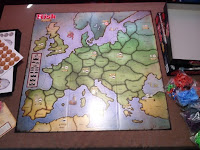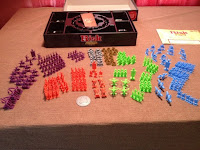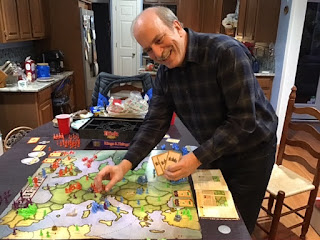In the height of the Dark Ages, the bulk of the island of Britain had pretty much become the domain of the Anglo-Saxons, and was divided into multiple smaller kingdoms with names like Wessex, Mercia, Cumbria, and more. And while the region itself was known as “England,” there was no one English nation, and no one English king. Despite this political disunity, the Saxons were enjoying a time of relative prosperity and peace— and then the Vikings came. Racing across the North Sea in their dragon-headed longships, Scandinavian raiders launched a series of bloody invasions, bent largely on plunder. For over two hundred years, they preyed upon the coast (at first) and then surged into the mainland (not unlike the Saxons themselves had done to the hapless Britons some three centuries before). Eventually these Scandinavian intruders set up their own kingdoms, or forced nominal Saxon kings to be puppet rulers for their new Danish masters. Despite being essentially out-numbered by the locals, the Vikings were able to run wild because the Saxon kingdoms largely fought them piece-meal, and frequently failed to team-up to stand against the hordes. Finally, a lone Saxon king, Alfred of Wessex, rose up against the “Danes” (as the Saxons called them), and defeated their greatest army in a grand battle. Using this victory, Alfred was able to force the Treaty of Wedmore upon the interlopers— and thereby created the Kingdom of England.
878•Vikings: Invasion of England from Academy Games seeks to recreate the strategic situation of the times, when sizable Viking armies landed on the coast of England and raided, plundered, and eventually settled the countryside, while being resisted by the scattered Saxon leaders. “878” is not a reference to the number of Vikings invading England, but the year in which the Anglo Saxon Chronicles record the raids beginning— 878 A.D.. Personally, I think the title may be the most uninspiring case of board game naming I’ve encountered. But despite this, the game itself is quite the opposite— challenging, engaging, and most of all a lot of fun.
Don't mind Sven. He's just a friendly sailor looking for loot.
IT’S TRUE- ENGLAND IS A LAND OF TREASURE— OR AT LEAST NIFTY STUFF
 |
| Speaking of loot! This hoard includes a horde! |
There’s a lot in the box:
A nicely sized (but not too large) game board featuring a map of 9th Century England.
Six full color card decks
21 Blue plastic miniatures of armored Saxon warriors (representing the “Huscarl” or “Housecarl” faction)
41 Green plastic miniatures miniatures of armored Saxon warriors with spears (representing “Thegn” faction)
10 Yellow plastic miniatures of Saxon peasants with spears (representing the “Fyrd,” or local levies, which are not a faction)
43 Black plastic miniatures of armored Viking warriors (representing the “Norsemen” faction)
21 Red plastic miniatures of unarmored Viking warriors with axes (representing the “Berserker” faction)
A single wood pawn as a “round” marker (basically the game clock).
15 thick cardboard “Viking Victory” tokens
6 thick cardboard Leader markers (mostly Vikings, but there is one of King Alfred the Great as well)
6 clear plastic stands to hold the Leader markers as standup pieces.
5 sets of different colored dice: Black (3), Red (2), Blue (2), Green (3), and Yellow (2)
4 colored cubes (basically dice without any markings): Black, Red, Blue and Green
A black cloth drawstring bag
As my set was from a Kickstarter set (purchased second-hand, yet still unplayed and unpunched), I also had four thick cardboard card holders, six “Saxon Navy” tokens, and several “Leader Movement” tokens (which we didn’t figure out what to do with), not to mention an expansion set with more rules and cards, Leader miniatures, and miniature Saxon churches, Viking forts and Viking settlements. Since these are not elements of the standard board game, I will hold off on reviewing these until we’ve had a chance to try them out.
VIKINGS, SIRE! THOUSANDS OF ‘EM!
 |
| Put on the Led Zeppelin track... "A-A-A-AAAA!" |
The game can be played by either two players, or by four players divided into opposing alliances. My gaming buddy Will and I gathered for an initial run through with the two-player version, but we agreed at the end that the game felt more like a four-player game, even with the fact that there are only two “sides” in the game.
The two sides to the game are the Saxons, who inhabit England, and the Vikings, who want to raid, plunder, and maybe inhabit England too. These sides are further divided into two “factions”each — for the Saxons, the Huscarls (the elite forces of the various kings, also called “Housecarls” in the game) and the Thegns (the forces of more localized rulers). For the Vikings, the factions are the Norsemen (“ordinary” viking warriors) and Berserkers (blood-thirsty fanatics with a death wish).
All factions essentially play the same and can even temporarily control forces of the other allied faction, but each have their own deck of command cards, and each have different combat probabilities based on their unique dice.
The object of the game is fairly straightforward: The Vikings seek to capture as many Saxon city territories as possible, tracking these conquests using the Viking Victory Track at the bottom of the map. The Saxons seek to stop the Vikings, at the very least by limiting the number of cities the Vikings capture, or if possible, eliminating all the Vikings from England. The game also includes four special “Treaty of Wedmore” cards, one for each faction; if at least two of these cards have been played, the treaty takes effect, the game ends and the victory conditions are checked.
The game starts with the two Saxon factions’ forces spread about the board in groups of 1, 2, 3, 4 or 5 figures of mixed color (Green and/or Blue). The Viking player will move first (though the movement order will change), and begins with a large force of Norsemen and Berserkers on a Leader card, which immediately “lands” on a coastal territory of his choice (early in the game, this can only be on the North Sea— later it can be any sea). Looking at this force, it will seem enormous— well over two dozen or more figures landing and moving from a single territory. (Recall those Saxon groupings of at most five figures? They’re doomed.) Viking invasion, indeed! Yikes!
ROUND AND ROUND WE GO
 |
| Round marker, King Alfred waiting to arrive, turn order cubes, and "fled" units waiting as reserves. Plus a Beserker faction movement card over to the side. |
The game is played in 7 “rounds” (though it can end sooner) consisting of 4 “turns” each. All factions have one turn per round, but the order of these turns is random, determined by a blind draw from the velvet bag containing the four colored cubes. Whichever color is drawn indicates the faction who has the current turn. That faction completes its actions, and a new cube is drawn. Once all four cubes have been drawn and the factions have acted, the game advances to the next round and the cubes are returned to the bag.
The rounds are tracked, because on the 5th round, Alfred the Great enters the fight as a Saxon leader, and the possibility of an end to the game goes up. (It’s also possible for the game to end earlier, but not likely.)
When the first Viking faction is drawn in a round, that faction draws a Viking Leader card, which triggers an invasion. (This is in addition to any invasion already going on from the previous round.) On that card are placed an entirely new army of Vikings of mixed factions. For the Saxon player, this is a case of “They. Just. Keep. Coming!”
MOVE ‘EM OUT! OR WHATEVER THEY YELLED IN OLD ENGLISH!
The thrust of a turn is simple: The faction player choose one Movement command card from a hand of three potential commands and plays it. (If he doesn’t have a Movement card in his hand, he must discard the hand and draw three new cards, continuing to discard and draw in this manner until he has at least one Movement card in his hand— which might also be a Treaty card). When the card has been played, the player then carries out the movement the card allows. For example, a Movement card may state that the faction my move 2 armies 4 spaces each. An “army” is any collection of any number of allied pieces which are all in the same territory, or on a Leader’s card— but the army must include at least one figure of the active faction’s color in order to be moved. For example, if it is the Thegn (Green) player’s turn, this card would allow him to move any two armies containing at least one green piece, each army moving up to four adjacent territories. If an army enters a territory occupied by an enemy, the moving army must stop, and combat will occur.
Leaders with armies have the ability to continue moving their specific army if they eliminate the enemy forces in one roll of the dice.
Other cards may be played as well that offer other effects to either aid the card’s faction or hamper the enemy. These cards can sometimes be played out of turn. It should also be noted that the Treaty cards are also Movement cards, which means that if a faction’s only Movement card on a turn is a Treaty card, it must be played, even if the player would rather not do so.
KILL, RETREAT, OR FLEE
Once a player has moved all his forces, if any share a territory with an enemy, these must engage in battle. Each force has dice that match the force’s color, and only the dice which match a force’s color will be rolled. The number of dice also may not exceed the number of matching figures in the battle. The dice are rolled simultaneously for all forces in the battle. Results are straightforward: Each roll result of swords (or axes for Viking dice) is a hit against the enemy, removing a figure for each hit. Results of a running man means that a matching colored figure is forced to flee (being placed in a “Fled” space on the map). Each horn rolled indicates that a matching colored figure may instead withdraw to an adjacent territory containing only friendly forces. A blank result means no effect occurs. All dice results of a roll are applied immediately for both sides. If neither side is eliminated (whether due to hits, withdrawals or flight), the dice are rolled again, repeating until only one side has forces remaining in the territory. Player should pay attention to the number of symbols on each die, as different factions and forces are better at combat than others (for example, Berserkers never flee!).
Once all movement and any combat is completed, the active faction draws cards to restore its hand to three, and that faction’s turn ends.
WE NEED A FEW GOOD PLASTIC MEN
Reinforcements are indeed a part of the game. The Saxon factions can potentially gain new forces on their respective turns, provided forces are available in their reserves. These are placed according to symbols on the map, and are restricted to one or two figures being added to any given city. However, the Saxon player may also regain any Fled figures, placing these in other available locations as chosen by the player. The Viking factions only gain forces through the function of drawing a Leader card, or restoring Fled units to coastal regions controlled by other Viking figures.
EVEN THE YELLOW-BELLIED ONES
The Saxon player also has the (dubious) advantage of raising the Fyrd, which represent the peasant farmers of the day taking up arms when their lands are threatened. If a Viking force attacks a Saxon army on a city territory, the Saxon player draws a card from a special Fyrd deck, and places the indicated number of yellow Fyrd figures in the territory. The Fyrd cannot be ordered to move, and exist only to aid in battle, for which they are ill equipped (they are more likely to flee than fight, or even do nothing at all). They’re not great troops, but they can take hits— preserving the better Huscarls and Thegns— and occasionally even manage to strike an enemy.
 |
| Thegn faction cards, attack dice and men. If you're the Saxon player, you'll want more of these. But there aren't any... |
SIMPLE PLAY, COMPLEX STRATEGY
And that’s about it for the rules. There are a few special conditions here and there, and the unique faction cards can throw in twists, but there’s little more to it. Though the game at first glance looks complex, it’s actually quite easy to grasp— if you can play Risk, you can definitely play this. However, the strategy is far richer and deeper than one might expect. The alternating flow of faction turns, with uncertainty as to who moves when, calls for careful planning. It may seem to be better to be first in a round, but if you’re not careful, all your gains can be wiped out by the last faction to take its turn!
YOU LOOK GOOD IN HORNS, WILL
 |
| The Great Heathen Host (says so, right on the card). The Viking side starts with this... and keeps adding more. |
It didn’t take too long for Will and I to leap into the game. He opted for the Viking invaders, and on his first turn I was wondering about the viability of my Saxon forces— there were a boatload of Vikings on his Leader card, and I couldn’t see how my puny, scattered troops could stand up to the onslaught of The Great Heathen Host (as the Saxon chroniclers dubbed the Viking invaders).
But that’s where the movement restrictions come in; the Viking faction has a lot of men, but they’re not going far at first. As he divides them up to attack the city territories which he must have to win, the Host begins to dwindle— and if he’s gone inland, he’s not getting reinforcements quickly. Meanwhile, the Saxons are often in a good distance to converge on the Vikings, while gaining inland reinforcements on each faction’s turn.
Pretty soon we were knocking each other back and forth across the map, and I was feeling good about my position. Will was gaining cities, but I kept hitting him back below his necessary victory number (9), while I managed to get out an early Treaty card.
Alas, my second needed Treaty card just refused to turn up. And Will started claiming my important reinforcement locations, reducing the forces I could bring to bear. But even up to the 7th round, I thought I had him beat. I had lost Alfred the Great, but I had pummeled Will down to 6 Victory cities claimed, out of a necessary 9. And that’s when I discovered I had failed to consider the chance that one of Will’s Viking factions would move last. Yet another horde descended upon my hapless defenders, and whack, whack, whack, he reconquered the cities he needed and claimed the crown. Alas, despite all advantages and positive omens (I mean, “Howard” is a good Anglo-Saxon name— “Heoward,” for “Royal Guardian”— I should win this fight, right?), my defense proved less than great.
HOY, SVEN— WANNA INVADE ENGLAND AGAIN?
The answer to that question is a hearty “Yes!” 878•Vikings: Invasions of England proved to be one of the best light wargames I have added to my collection. The look is gorgeous and thematically perfect (I especially love the Old English names on the map), and the components are of solid quality, and spot on in appearance. But even better, the rules are simple without being simplistic— players aren’t bogged down in complexity, though the game still feels like the historical situation it intends to represent, and the strategic challenges are rich and varied. “Elegant” truly is the operative word here. Plus, the game is just plain fun. Our conflict was a thing of constant triumphs and reversals, with just enough luck introduced by the dice and cards, yet never the feeling that we were at the whims of fortune. And the faction structure is well done— though we only tried the two-player approach, it was clear that an allied game would have enough independent action and decision making that no one would wind up feeling like a second fiddle. I expect that we will be returning to this game again and again— rather like the Vikings eyeing England across the North Sea.
— Parzival, the Wargamesmonger.
















